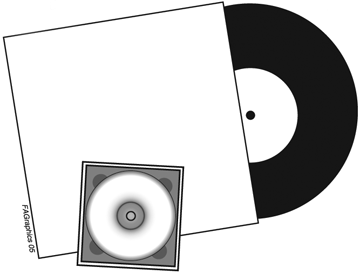Compact disks have been the medium of recorded music for the past 15 years. If you’ve only ever listened to CD’s, you might not even know how original vinyl records sounded. You probably would not think that the musical integrity of the recording is an issue… but there are some people who do.

Are Records Better than CD’s?
By Mary E. Shacklett
Published: November, 2005
Compact disks have been the medium of recorded music for the past 15 years. If you’ve only ever listened to CD’s, you might not even know how original vinyl records sounded. You probably would not think that the musical integrity of the recording is an issue… but there are some people who do.
CDs versus vinyl recordings have been most hotly debated when it comes to the Blues. This is because the Blues is a musical idiom that depends on nuance, inflection, the bending of musical notes to evoke emotion, and the use of other musical subtleties that combine to convey the message of the music.
This columnist surveyed blues fans around the country on which form of recorded blues they preferred — CD’s or records. Interviewees actually split into two different camps, and this is what they had to say:
Two sounds camps
The pro-CD group argued that CDs made the best Blues recordings because the original sounds were remastered into clean recordings. The hissing and background noises of the original vinyl-based recordings, made during a time when recording was less sophisticated, were eliminated. The resulting sounds of remastered recordings were clean, distilled and free of outside interference. In many cases, sound resolution had been improved to where jumbled or muddy lyrics on the vinyl versions of the recordings were suddenly rendered understandable.
The pro-vinyl group countered that the original artistic integrity of blues recordings is compromised when the recordings are remastered into CD’s, which are digital technology. The group went on to say that part of the authenticity of older blues recordings in particular is the background scratchiness of these original recordings, which somehow contributes to the overall ambiance of the work. This group also felt that many of the subtle nuances of the Blues, such as higher frequency overtones generated by the notes played, and the technique of bending a note on an instrument or a voice, which is the signature of the Blues, were lost in the remastering process to the digitally based technology of CD’s. These Blues purists argued that to really enjoy the complete experience of listening to the Blues, you have to listen to records and not to CD’s.
The CD-vinyl argument
Live music produces analog sound waves that are captured by the ears of listeners. These sound waves contain not only the frequencies of the musical notes played or sung, but the overtones of these notes at higher pitched frequencies. The listener might not always be consciously aware of these overtones, but their presence creates a full and a rich quality to the notes being played. Some have termed this a three dimensional listening experience.
In the original vinyl-based recordings of the Blues (or any music), the technology was imperfect when it came to screening out background noises and the sounds of the equipment recording the music—in the same way that a live performance is imperfect when the listener hears someone drop a glass near the soundstage during the performance. However, vinyl-based recording directly captures the analog sound waves emitted by the music, and vinyl records are direct analog copies of a musical event.
The digital sound technology used to make CDs works differently.
In a digital recording for a CD, sounds are sampled digitally, and reconverted into analog sound. This digital sampling of the music occurs at intervals along the musical continuum, and is not continuous like the music or the sound waves. Consequently, there are intermittent gaps in digital recordings. A good comparison is the contrast of a high-quality photograph with a digital image. Details and colors are richer in the film-based photograph. The digital recreation of the photograph has tiny dots or gaps in the picture that cloud the resolution.
When old recordings are remastered, background noises and the sounds of recording equipment can be eliminated in the digital recording by editing out those sounds. The tradeoff is that other qualities in the music (such as overtones that exist at higher frequency levels) are also eliminated. This leaves a crisp musical recording that is firmly rooted in the middle spectrum of the sound range, but that does not include the total sound range of an analog recording.
The debate over the Blues and other music on CDs or vinyl is likely never to be resolved, and is one example of how technology is remaking art.

